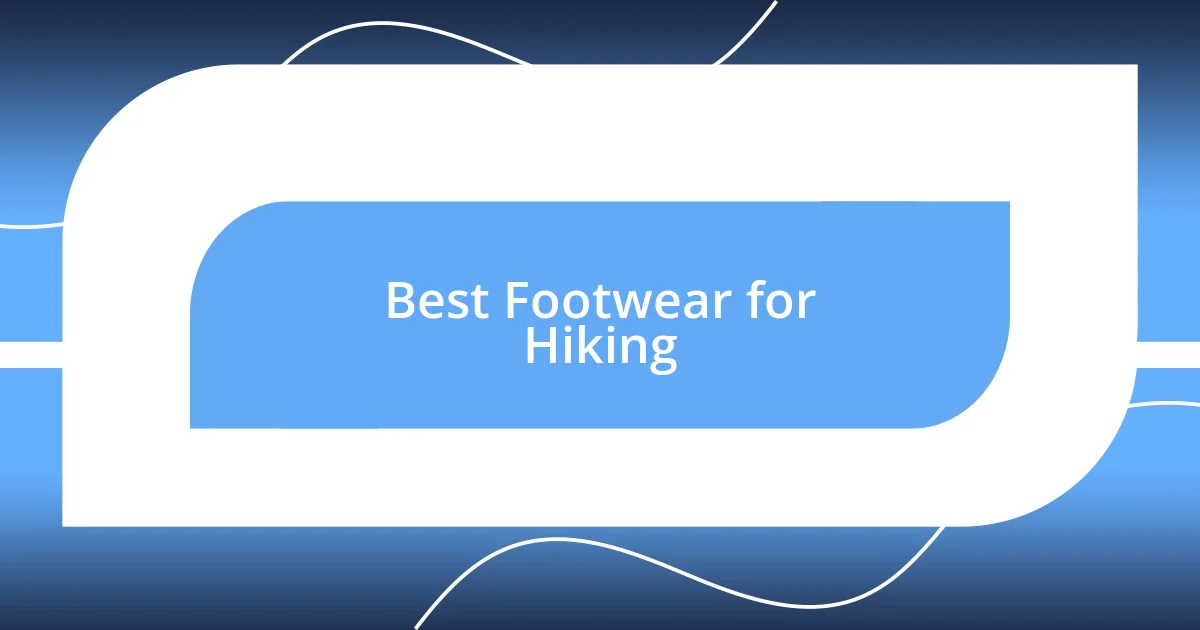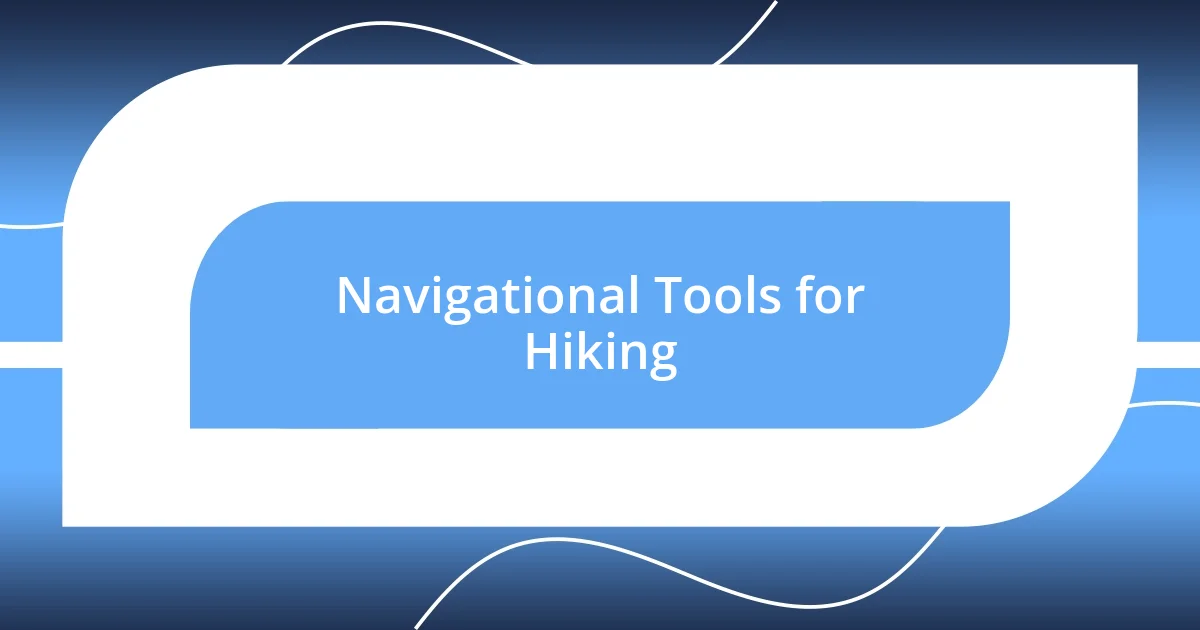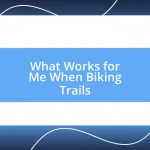Key takeaways:
- Sturdy hiking boots and a well-fitted backpack are crucial for comfort and support during hikes, impacting overall enjoyment and performance.
- Layering clothing and using moisture-wicking materials can greatly enhance comfort and adaptability to changing weather conditions on the trail.
- Safety equipment, such as a first aid kit, reliable footwear, and navigational tools, is essential for ensuring a secure and enjoyable hiking experience.

Essential Gear for Hiking
When I think about essential gear for hiking, the first item that comes to mind is my sturdy pair of hiking boots. I can still recall the time I attempted a long trek with worn-out sneakers, and my feet felt like they were on fire halfway through. The right boots not only provide support but also grip, allowing you to navigate rocky paths with confidence. Have you ever tried walking on a slippery surface? It’s a game-changer when you have footwear designed for it.
Equally important is a well-fitted backpack. I remember my first hike with a poorly adjusted pack; it felt like I was carrying a boulder, and by the end, my shoulders ached something fierce. A proper backpack should distribute weight evenly and offer the right amount of space for your gear. It’s incredible how a little thoughtful packing can change your experience on the trail!
Don’t underestimate the significance of hydration systems. I learned that the hard way during a particularly hot hike when I ran out of water too soon. Staying hydrated is crucial for maintaining energy levels and enjoying the beautiful scenery around you. Have you ever felt that refreshing sip of water after a long stretch? It’s a small pleasure that makes all the effort worthwhile.

Best Footwear for Hiking
When I lace up my hiking boots, I feel like I’m preparing for an adventure. I vividly remember a time when I chose style over comfort during a day hike and ended up with blisters that had me limping for days. It’s essential to find footwear that is not only durable but also offers a perfect fit; this ensures I can focus on the stunning views ahead rather than the pain in my feet. Lightweight options like trail runners can be fantastic for well-maintained trails, but nothing compares to the support of a rugged pair of boots when faced with challenging terrains.
I’ve also discovered the importance of weather-appropriate footwear. There was one memorable hike on a rainy day when I wore my water-resistant boots, and they kept my feet dry and warm. It made a significant difference in my overall comfort and enjoyment of the hike. If you’re venturing onto slippery or muddy trails, waterproof options with good traction are non-negotiable; trust me, it can save you from some awkward slips and falls.
Finally, let’s not overlook the value of break-in time. I learned this the hard way on a weekend backpacking trip. New boots might look pristine and inviting, but taking them out for a quick walk around the neighborhood first can prevent blisters and discomfort. That little preparation makes all the difference in ensuring those beautiful views don’t come paired with aching feet.
| Footwear Type | Best For |
|---|---|
| Hiking Boots | Rugged terrains and extended hikes |
| Trail Runners | Well-maintained trails and lightweight trips |
| Waterproof Boots | Wet and slippery conditions |

Top Clothing for Hiking
When it comes to hiking clothing, I can’t stress enough the importance of layering. On one memorable hike, I was caught in an unexpected downpour, and my decision to wear moisture-wicking base layers saved the day. I felt significantly more comfortable as the rain drizzled down—it was a simple adjustment that allowed me to focus on enjoying the scenery rather than shivering in wet gear. The top layer served as a shield against the elements, keeping me dry and warm.
Here are some key clothing pieces to consider for your next adventure:
- Moisture-Wicking Base Layers: These keep sweat away from your skin, helping to regulate body temperature.
- Insulating Mid Layers: Think fleeces or merino wool, which provide warmth without bulk. I once climbed a chilly mountain in a fleece that made all the difference in my comfort.
- Waterproof Outer Shells: Essential for wind and rain protection, a good jacket can turn a miserable hike into an enjoyable one, as I learned when I wore mine during a surprise storm.
- Hiking Pants: Look for breathable, stretchable fabrics. On challenging ascents, I appreciate having pants that allow for easy movement while also being durable against scrapes and scratches from overgrown paths.
- Hiking Socks: Don’t underestimate the power of quality socks! I had a hike that turned painful because I went with cotton instead of my favorite moisture-wicking ones.
Layering is not just practical; it can take your hiking experience from uncomfortable to exhilarating, allowing you to fully embrace the great outdoors. Remember, it’s all about being prepared so you can enjoy the journey ahead!

Must-Have Backpack Features
When selecting a backpack, the fit is crucial. I’ve had my share of misadventures with improperly fitted packs. One time, I tightened the straps on a bulky backpack, thinking it would keep my load steady. Instead, it caused constant discomfort, making me question every mile of my hike. That experience taught me that an adjustable harness and hip belt can make all the difference, allowing for a snug fit that distributes weight and prevents those nagging aches.
Another feature I can’t live without is ample storage, particularly with pockets that are easily accessible. During a long hike, I once found myself fumbling through my pack for a snack, only to realize I’d buried it under a pile of gear. Frustrating, right? Now, I always opt for backpacks with outer pockets for water bottles and quick-access snack pouches. This small detail allows me to stay fueled and hydrated without disrupting my rhythm, resulting in a more enjoyable trek.
Lastly, hydration compatibility is a must-have. I remember a sweltering day when I neglected to check for a hydration reservoir pocket. Halfway through the hike, my water supply dwindled—and let me tell you, nothing takes the joy out of hiking quite like dehydration! Backpacks equipped with hydration reservoirs or compartments make staying hydrated easier and more efficient, especially on those hot days when every sip counts.

Key Accessories for Comfort
When it comes to enhancing comfort on the trail, I can’t help but highlight the importance of trekking poles. On one particularly exhausting hike, my knees were feeling the strain of steep descents, and I wished I had those trusty poles with me. They not only help in maintaining balance but also reduce impact on your joints, allowing for a smoother journey as you navigate rugged terrain. Isn’t it amazing how a simple tool can transform the way we hike?
Another accessory I hold dear is a comfortable hat. I remember a sunny hike where sun exposure quickly wore me down. I hadn’t brought my favorite lightweight, breathable cap to shield my face from the glaring sun. The simple shading it provides makes a huge difference in my energy levels and focus. You’ll be surprised how much a hat can keep you cool and comfortable, making it easier to enjoy the natural beauty around you.
Lastly, let’s not forget about a quality pair of sunglasses. There was a hike I took through a stunning mountain range, but blinding sunlight made it hard to truly appreciate the views. I quickly remembered to wear my polarized shades, and the world transformed into a vivid landscape free from glare. Protecting your eyes not only adds comfort but enhances the overall experience, allowing you to soak in every detail of your adventure. Have you ever considered how small accessories can play a vital role in your comfort during outdoor activities?

Navigational Tools for Hiking
Navigational tools can truly elevate your hiking experience, and I’ve learned that the right gear can be a game-changer. When I ventured into the unmarked trails of a national park, having a reliable GPS device made all the difference. I remember glancing at it nervously at one point, unsure if I was going in circles, only to find a reassuring green line guiding me back on track. It’s moments like these that highlight the peace of mind a good navigational tool provides.
In addition to GPS devices, I always carry a physical map and compass, which might feel a bit old-school but are invaluable in certain situations. I once faced a sudden downpour in the mountains, and while my GPS struggled, my trusty map and compass guided me safely to shelter. There’s something incredibly grounding about using these classic tools, reminding me that technology doesn’t always have the last word in navigating nature.
Lastly, I can’t emphasize enough the importance of a good hiking app on my smartphone. I was once hiking a popular trail, and my app helped me discover a hidden lookout, away from the crowds. It’s amazing how technology can connect us with unexpected gems in nature. Have you considered how navigational tools not only keep you on track but can also uncover new paths to explore?

Safety Equipment for Outdoor Adventures
When venturing into the great outdoors, safety equipment should be at the forefront of your mind. A trusty first aid kit is a must-have, and I’ve learned this the hard way. During one hike, I twisted my ankle on an uneven trail, and having that kit meant I could address the pain and continue my journey—well, sort of. The peace of mind a solid first aid kit provides is invaluable; it’s like having a safety net that allows you to explore with confidence.
It’s also essential to wear a quality pair of hiking boots that offer solid ankle support. I remember an adventurous hike that turned challenging due to slippery surfaces, but my boots kept me steady. They not only cushioned my feet but also provided essential grip, preventing potential falls. Have you ever thought about how the right footwear can literally save you from a tumble? It’s a small detail that often goes overlooked, yet it can significantly impact your safety.
Don’t forget about carrying a whistle and a headlamp—both are often underestimated. I recall a scenario where I lost track of time while capturing the sunset. As darkness fell, my headlamp became my guiding light, illuminating the path ahead. Plus, a whistle? That can be a lifesaver if you need to call for help! Reflecting on these experiences, I’ve come to realize that safety gear allows me to enjoy my adventures with a sense of security. What safety essentials have you found to be indispensable on your hikes?














